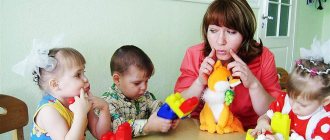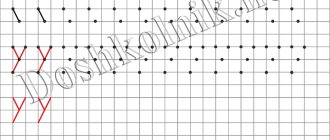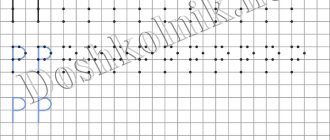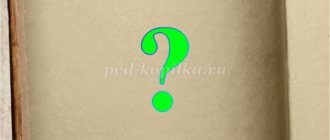“Sounds [Н], [Нь] and the letter N” - summary of an open speech therapy lesson in the preparatory group
Municipal budgetary preschool educational institution "Kindergarten No. 8 of the combined type of the city of Boksitogorsk"
Open lesson summary
Topic: “Sounds N, N and the letter N”
Prepared by: teacher-speech therapist of the 1st qualification category Timofeeva Victoria Alekseevna
Boksitogorsk,
2016-2017
Target:
consolidate the skills of sound-syllable and sound-letter analysis and synthesis of the sounds N, N and the letter N in didactic games using innovative technologies.
Tasks:
Correctional and educational:
- Develop skills in phonemic representations with sounds [Н-Нь];
- Fix the correct pronunciation of sounds [Н-Нь] in syllables, words, phrases;
- Reinforce the concepts of “consonant”, “hard”, “soft”;
- Develop reading skills of forward and backward syllables;
- Develop the ability to coordinate numerals with possessive adjectives and nouns;
Correctional and developmental:
- Develop articulation, general and fine motor skills, coordination of speech with movement;
- Develop auditory attention;
- Develop phonemic attention and perception;
- Develop the ability to hear a question and answer it;
- Develop logical thinking, visual perception, memory;
- Form ideas (elements) of experimental activities;
- Develop the ability to solve simple puzzles;
- Introduce Russian proverbs and sayings;
Correctional and educational:
- Develop skills of activity, cooperation, the ability to listen to the teacher and each other.
Equipment:
projector, screen, laptop, bell, presentation for an open lesson “Sounds N, N and the letter N”, six mirrors (according to the number of children), paper napkins, a tambourine, two audio recordings (the sounds of a hooting owl, the sounds of three horses with bells), owl-mitten, ball, Christmas tree, wooden beads of blue, red and green colors of different sizes and shapes, six laces, six envelopes with Tangram squares (three green squares, three blue squares), cut alphabet letters, a box of children's chocolates .
Progress of the lesson
- Organizing time:
(children with a speech therapist teacher enter the hall)
— Guys, say hello to our guests. (Hello.) Guys, stand in the circle of “Friendship”:
Smile at each other, make friends with each other! Tight tight.
(Guys hold hands, squeeze hands)
(the signal assistant rings the bell)
- Attention, the magic bell has rung and our lesson will begin... ordered
(the children repeat the last word together with the speech therapist). Go ahead and sit at the tables.
- Articulation gymnastics (with presentation):
You are seated in order, Let’s do some exercises together, Not with your feet, not with your hands (stomp, clap), But with your… tongues
(children repeat the last word together with the speech therapist)!
Note:
articulatory gymnastics is performed to the rhythm of a tambourine.
- Didactic game “Pure sayings and additions”:
(sounds of an owl hooting are heard)
— Guys, what are these sounds (on the slide is a picture of a winter forest)? Where are they from? From the forest? (the speech therapist looks behind the screen and appears with an owl-mitten)
- Guys, meet the Very Wise Owl. The news spread throughout the forest that in our kindergarten the children of the preparatory group can play “Pure Sayers - Additions”. Shall we play? (Yes.)
(pictures of answers appear on the slide by clicking as children answer; the child who first names the answer repeats the phrase)
- On the! On the! On the! At night ... (moon) shines for us.
- On the! On the! On the! The guitar broke... (string).
- On the! On the! On the! Russia is my favorite...(country).
- But! But! But! At the top of the hat... (bottom).
- But! But! But! We sawed... (log).
- But! But! But! Hanging on the wall... (panel)
- But! But! But! The ball hit ... (window) again.
- Well! Well! Well! You dived under... (wave).
- Lesson topic message:
- Well done! What sound is heard in the words: lu n
a,
string
,
country
,
bottom
,
log
,
panel
,
window
,
wave
? (child’s answer: Sound [N]).
- Right! Guys, the sound [N] - what sound is it: a vowel or a consonant; soft or hard? Repeat the sound [N] with a fist (children repeat the sound [N] several times, knocking on the table with their fist, associating it with hardness). — What color do we use to indicate the hard consonant sound [H]?
(The hard consonant sound [H] is indicated in blue).
— What will the soft consonant [Нь] sound like? Repeat it. (Children, together with a speech therapist, repeat the sound [Нь] several times in an exercise with hands: gather all the fingers on each hand into a ring and, when naming the sound, open them like a fan.)
— What color do we use to indicate the soft consonant sound [Нь]?
(The soft consonant sound [Нь] is indicated in green).
- Right! Sovunya has prepared interesting games for you with the sounds [N] - [N]. Shall we play? (Yes.)
- Syllable warm-up with sounds [Н] - [Нь] with a ball:
- Guys, stand behind the chairs and get your little hands ready. Syllable warm-up with sounds [Н] - [Нь].
Na-nya-na No-no-but Well-nu-well No-no-no
An-an-an He-on-on Un-un-un Eun-eun-eun
- Well done! Take your seats.
- Didactic game “The fourth odd one (with presentation):
— Let's play the game “Fourth Wheel.” Guys, name the pictures. Find the extra picture. Explain why it is redundant?
- Threads, night,
low, Nikita
- Son,
horse, stump, fire
- loaf, deer,
ocean, throne
- Nose, nails, socks, threads
- Skates,
sleds, tanks, candies
- Book, ruler, pencil,
strawberries
- Finger gymnastics “Pathfinder”:
— Guys, what time of year is it now? (Winter.)
— What color is winter? (White.)
- Why is everything around white? (Because everything is covered with snow.)
— What do people and animals leave in the snow? (Footprints.)
- Let's play tracker with our fingers. (On the slide there are forest clearings with footprints in the snow.) (Perform in the “Chain” exercise.)
The tracker follows the trail, the trail leads him through the snow.
- Didactic game “Count the tracks”:
— There is a lot of snow in the winter forest. Shall we play pathfinders with Sovushka? (Yes.)
- Guys, leave the tables, stand in a semicircle.
(slide with boar tracks)
- Guys, who is this? (This is a boar.)
- Whose footprints are these in the snow? (These are boar tracks in the snow.)
- Count the boar tracks in the snow one by one. (The first child starts counting, the next one continues, etc. according to the number of children.)
Example:
one boar track in the snow, two boar tracks in the snow, three boar tracks in the snow, etc.
- Well done! Well counted the boar tracks. Shh! That's it, the boar ran away.
(On the slide there are forest clearings with footprints in the snow.)
- Physical education minute:
- Guys, the frost is not great, but it doesn’t tell you to stand (proverb). Let's warm up? (Yes.)
Poem with the movement "Frost"
| Fingers are freezing | (squeezing and unclenching hands) |
| Stings nose | (with index fingers touch the tip of the nose, the remaining fingers are clenched into fists) |
| Frost creeps into felt boots | (jumping in turns on one leg) |
| We are not afraid of frost | (hands on the belt, turns to the sides) |
| Let's keep having fun | (exercise “Stomp-clap”) |
| We walk through the snowdrifts, lifting our legs higher | (raise your legs high) |
| Right - clap and left - clap | (claps hands) |
| Look, there's a snowdrift there! | (point with your hand at the “snowdrift” of “snowballs”, children look for the “snowdrift” with their eyes) |
- Guessing the riddle:
(sounds of three horses passing by)
- Guys, what are these sounds? Guess the riddle:
They are beautiful, graceful, Their element is the excitement of the chase, Taking barriers masterfully, Flying faster than the wind
...
(Horses)
.
S. Ustabekov
- That's right! A Russian proverb says: “Horses run more happily home.” It's time for us to go back to kindergarten. "Goodbye" Owl. Close your eyes; one, two, three, four, five - here we are in kindergarten again! Open your eyes.
- Didactic game “Christmas tree decoration”:
— Guys, go and sit at the tables (on the tables there are two metal boxes in the shape of Christmas tree balls, and there are additionally six fabric napkins). What winter holiday is coming soon? (New Year is coming soon!)
— It’s customary to decorate the Christmas tree on New Year’s Day. Let's make a Christmas tree decoration from wooden beads. The decoration is not simple, but it is sound. Who drove past us through the forest with the news of the approaching holiday? (Horses.) (slide on screen).
- Name the first sound in the word “K-oni”. (Sound [K]).
- What sound is it: vowel or consonant; soft or hard? Take the hard sound bead [K]. String it.
- Name the sound following the sound [k] in the word “k-O-ni.” (Sound [O]).
- What sound is this: a vowel or a consonant? Take the vowel bead [O]. String it so that it is the second in a row (counting from left to right).
- Name the sound following the sound [o] in the word “ko-Ni-i.” (Sound [Нь]).
- What sound is it: vowel or consonant; soft or hard? Take the soft sound bead [Нь]. String it so that it is the third in a row (counting from left to right).
- Name the last sound in the word “konI”. (Sound [I]).
- What sound is this: a vowel or a consonant? Take the bead of the vowel sound [I]. String it so that it is the last one in a row (counting from left to right).
Note:
At the request of the speech therapist, the children take turns naming all the sounds in the word, clapping each syllable, and repeating the rule: “As many vowels as there are in a word, there are as many syllables.”
- Guys, well done! This is a beautiful decoration, tie the beads with a bow and let’s go decorate our Christmas tree.
- Didactic puzzle game “Tangram” with an element of experimental activity:
- Guys, look, there are envelopes under the Christmas tree. Santa Claus probably prepared them for you. Take them and take your seats. Look what's inside. (The guys lay out a cut square “Tangram” on the table).
Note:
three squares are green, three squares are blue.
— This is a tangram puzzle game. Assemble the square so that you get a symbol like in the picture. (Slide on screen).
- Guys, now place your mirrors at the top of the square, what do you see? (This is the letter N).
- Right! (presentation slide with a poem about the letter N).
- Oh, here’s the New Year’s letter-N. Read it three times in chorus. (N-N-N).
- Reading simple syllables:
— Guys, remember that the letter N is read differently in different syllables: with a hard sound and a soft sound. The Tangram square reminds you of this!
- Guys, read the syllables with the letter N at the end: (alternate reading) AN, UN, ON, IN.
— Guys, read the syllables with the letter N at the beginning: (alternate reading) NA, NU, BUT, NI.
- Didactic game "Rebus": (slide on screen)
- Guys, solve the puzzle and you will find out the name of our Very Wise Owl, without whom our lesson would not be so exciting. Remember the rule: people's names and animal names are written with a capital letter. Be careful when solving the puzzle.
- Arrange the letters according to their serial numbers. (Children have split alphabet letters).
| 4 | 2 | 3 | 1 |
| A | And | n | N |
- Well done! Read the owl's name (everyone claps together).
- Summing up the lesson:
- Guys, today in class we repeated the sounds N, N and the letter N. (Slide with the letter-N).
— What games and tasks did each of you remember most and like? (children's answers).
- Guys, you did a great job, you coped well with the tasks of Nina the Very Wise Owl and Grandfather Frost! I sincerely congratulate you all on the upcoming holiday, grow up smart, and share this sweet gift from Grandfather Frost among all the children in your group. Bon appetit and see you again with our guests. Say "Goodbye!" and let's go to the group.
NNOD move:
Introduction to the topic
– Guys, do you like fairy tales? Who is your favorite fairy-tale hero? Today a fairy-tale hero will also come to us. And you will find out who it is if you guess the riddle:
Blue hat, Yellow pants, In the city of Flowers - The main braggart.
This Shorty tried to rhyme, But he did not become a True poet.
Many adventures happened to him, But it’s worth admitting, This boy is cute.
Who is this? Guess it! The baby's name is . (Dunno)
Children sit at tables and open their workbooks.
Game "Give me a word"
- Dunno, he wants to play the game “Give me a word” with you. Listen carefully, find the clue in your notebooks and circle the clue picture.
And the rooster with the prickly hedgehog cuts the lard with sharp edges. (With a knife)
Who alone has a horn? Guess it! (Rhinoceros)
– What is the first sound in the words “KNIFE” and “RHINO”? (“N”).
Working with mirrors. Characteristics of the sound “N”
– Say the sound “N”. In what position are the lips, teeth, tongue? What prevents sound from coming out? Tell Dunno, what sound is this? The sound “N” is a consonant, voiced hard or soft. What color do we use to indicate the consonant hard sound “N”? (blue). What about the soft consonant sound “Нь”? (green)
Game “Locate the place of the sound in the word”
– Name the pictures, emphasizing the “N” sound. Dunno does not know where the sound “N” is located in the word “ELEPHANT”. Let's give him a hint and draw a blue square in the appropriate place in the diagram.
Using tactile exercises
The child’s tactile sensations also need to be connected when learning the letter n. After all, these exercises activate the brain of a small person.
- Draw a symbol on the baby’s palm, ask the child to say its name – “en” with his eyes closed.
- Draw an “H” with your palms parallel to each other and your thumb placed perpendicular.
- Draw a symbol on a sheet of white paper with a finger dipped in watercolor paint or gouache.
- Make a letter from plasticine or salt dough and decorate the resulting figure.
- Draw the letter H with the crumbs' finger on the cereal, scattered in a thin layer on a horizontal surface.



